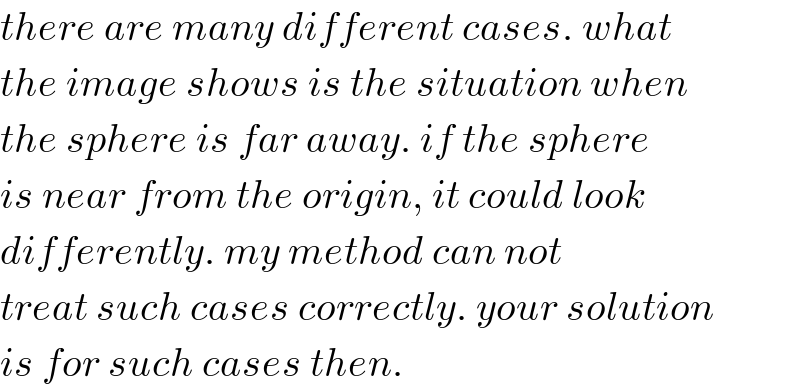Question Number 72672 by mr W last updated on 31/Oct/19

Commented by mr W last updated on 31/Oct/19

$${find}\:{u}_{{min}} \:{for}\:{the}\:{stone}\:{to}\:{hit}\:{the} \\ $$$${ground}\:{behind}\:{the}\:{sphere}. \\ $$$$\left({see}\:{also}\:{Q}\mathrm{72563},\:{with}\:{thanks}\:{to}\:\right. \\ $$$$\left.{ajfour}\:{sir}\:{for}\:{the}\:{orginal}\:{question}\right) \\ $$
Commented by malwaan last updated on 31/Oct/19

$$\boldsymbol{{very}}\:\boldsymbol{{easy}}\:! \\ $$
Answered by ajfour last updated on 31/Oct/19

$${y}={H}−{Ax}^{\mathrm{2}} \:\:\:\:\:\:\:\:\:{x}^{\mathrm{2}} +\left({y}−{R}\right)^{\mathrm{2}} ={R}^{\mathrm{2}} \\ $$$${y}=\frac{{u}^{\mathrm{2}} \mathrm{sin}\:^{\mathrm{2}} \theta}{\mathrm{2}{g}}−{Ax}^{\mathrm{2}} \:\:\:\:\:\:\:\:\:\:….\left({i}\right) \\ $$$$\frac{\mathrm{2}{u}^{\mathrm{2}} \mathrm{sin}\:\theta\mathrm{cos}\:\theta}{{g}}=\mathrm{2}{d}\:\:\:\:\:\:\:\:\:\:…\left({ii}\right) \\ $$$${x}^{\mathrm{2}} +\left(\frac{{u}^{\mathrm{2}} \mathrm{sin}\:^{\mathrm{2}} \theta}{\mathrm{2}{g}}−{Ax}^{\mathrm{2}} −{R}\right)^{\mathrm{2}} ={R}^{\mathrm{2}} \\ $$$$\Rightarrow \\ $$$${x}^{\mathrm{2}} −\mathrm{2}{A}\left(\frac{{u}^{\mathrm{2}} \mathrm{sin}\:^{\mathrm{2}} \theta}{\mathrm{2}{g}}−{R}\right){x}^{\mathrm{2}} +{A}^{\mathrm{2}} {x}^{\mathrm{4}} \\ $$$$\:\:\:\:+\left(\frac{{u}^{\mathrm{2}} \mathrm{sin}\:^{\mathrm{2}} \theta}{\mathrm{2}{g}}−{R}\right)^{\mathrm{2}} −{R}^{\mathrm{2}} =\mathrm{0} \\ $$$${coeff}.\:{of}\:{x}^{\mathrm{2}} =\mathrm{0} \\ $$$$\begin{cases}{{further}\:{if}\:\:\:\frac{{u}^{\mathrm{2}} \mathrm{sin}\:^{\mathrm{2}} \theta}{\mathrm{2}{g}}=\mathrm{2}{R}}\\{{stone}\:{grazes}\:{the}\:{sphere}\:{top}}\end{cases} \\ $$$$\Rightarrow\:\:\mathrm{2}{A}\left(\frac{{u}^{\mathrm{2}} \mathrm{sin}\:^{\mathrm{2}} \theta}{\mathrm{2}{g}}−{R}\right)=\mathrm{1}\:\:\:\:\:…\left({iii}\right) \\ $$$${for}\:\:{x}={d}\:,\:{y}=\mathrm{0}\:\:\:{eq}.\:\left({i}\right)\:{then}\:{gives} \\ $$$${Ad}^{\mathrm{2}} =\frac{{u}^{\mathrm{2}} \mathrm{sin}\:^{\mathrm{2}} \theta}{\mathrm{2}{g}} \\ $$$${Now}\:{using}\:\left({iii}\right)\:{in}\:{here} \\ $$$${d}^{\mathrm{2}} =\frac{{u}^{\mathrm{2}} \mathrm{sin}\:^{\mathrm{2}} \theta}{\mathrm{2}{g}}×\mathrm{2}\left(\frac{{u}^{\mathrm{2}} \mathrm{sin}\:^{\mathrm{2}} \theta}{\mathrm{2}{g}}−{R}\right) \\ $$$${And}\:{from}\:\left({ii}\right) \\ $$$${u}^{\mathrm{2}} =\frac{{gd}}{\mathrm{sin}\:\theta\mathrm{cos}\:\theta}\:\Rightarrow\:\:\frac{{u}^{\mathrm{2}} \mathrm{sin}\:^{\mathrm{2}} \theta}{\mathrm{2}{g}}=\frac{{d}\mathrm{tan}\:\theta}{\mathrm{2}} \\ $$$$\Rightarrow\:\:{d}^{\mathrm{2}} =\:{d}\mathrm{tan}\:\theta\left(\frac{{d}\mathrm{tan}\:\theta}{\mathrm{2}}−{R}\right) \\ $$$$\:\:\:{t}=\:\mathrm{tan}\:\theta \\ $$$$\:\:\:{dt}^{\mathrm{2}} −\mathrm{2}{Rt}−\mathrm{2}{d}=\mathrm{0} \\ $$$$\Rightarrow\:\:{t}=\mathrm{tan}\:\theta=\frac{\mathrm{2}{R}+\sqrt{\mathrm{4}{R}^{\mathrm{2}} +\mathrm{8}{d}^{\mathrm{2}} }}{\mathrm{2}{d}} \\ $$$$\:\:\theta=\mathrm{tan}^{−\mathrm{1}} \left(\frac{{R}}{{d}}+\sqrt{\left(\frac{{R}}{{d}}\right)^{\mathrm{2}} +\mathrm{2}}\:\right) \\ $$$$\:\:{u}^{\mathrm{2}} =\frac{{gd}\mathrm{tan}\:\theta}{\mathrm{1}+\mathrm{tan}\:^{\mathrm{2}} \theta} \\ $$$$\:\:\:{u}^{\mathrm{2}} =\frac{{gd}\left(\frac{\mathrm{2}{R}+\sqrt{\mathrm{4}{R}^{\mathrm{2}} +\mathrm{8}{d}^{\mathrm{2}} }}{\mathrm{2}{d}}\right)}{\mathrm{1}+\left(\frac{\mathrm{2}{R}+\sqrt{\mathrm{4}{R}^{\mathrm{2}} +\mathrm{8}{d}^{\mathrm{2}} }}{\mathrm{2}{d}}\right)^{\mathrm{2}} } \\ $$$$….. \\ $$
Answered by mr W last updated on 31/Oct/19

Commented by mr W last updated on 31/Oct/19

$${there}\:{are}\:{many}\:{different}\:{cases}.\:{what} \\ $$$${the}\:{image}\:{shows}\:{is}\:{the}\:{situation}\:{when} \\ $$$${the}\:{sphere}\:{is}\:{far}\:{away}.\:{if}\:{the}\:{sphere} \\ $$$${is}\:{near}\:{from}\:{the}\:{origin},\:{it}\:{could}\:{look} \\ $$$${differently}.\:{my}\:{method}\:{can}\:{not} \\ $$$${treat}\:{such}\:{cases}\:{correctly}.\:{your}\:{solution} \\ $$$${is}\:{for}\:{such}\:{cases}\:{then}. \\ $$
Commented by mr W last updated on 31/Oct/19
![x=u cos θ t y=u sin θ t−((gt^2 )/2) y=x tan θ−(g/(2u^2 ))(1+tan^2 θ)x^2 let t=tan θ y=tx−(g/(2u^2 ))(1+t^2 )x^2 y′=t−((g(1+t^2 )x)/u^2 ) B(d+R sin ϕ, R(1+cos ϕ)) −tan ϕ=t−((g(1+t^2 )(d+R sin ϕ))/u^2 ) ⇒((g(1+t^2 )(d+R sin ϕ))/u^2 )=t+tan ϕ R(1+cos ϕ)=t(d+R sin ϕ)−(g/(2u^2 ))(1+t^2 )(d+R sin ϕ)^2 R(1+cos ϕ)=t(d+R sin ϕ)−(((d+R sin ϕ)(t+tan ϕ))/2) ⇒t=tan ϕ+((2(1+cos ϕ))/(δ+sin ϕ)) with δ=(d/R) ⇒((gR(1+t^2 )(δ+sin ϕ))/u^2 )=t+tan ϕ ⇒((gR)/u^2 )=((t+tan ϕ)/((δ+sin ϕ)(1+t^2 ))) ⇒((gR)/(2u^2 ))=U=((1+cos ϕ+(δ+sin ϕ)tan ϕ)/((δ+sin ϕ)^2 +[(δ+sin ϕ)tan ϕ+2(1+cos ϕ)]^2 )) (dU/dϕ)=0 .....](https://www.tinkutara.com/question/Q72701.png)
$${x}={u}\:\mathrm{cos}\:\theta\:{t} \\ $$$${y}={u}\:\mathrm{sin}\:\theta\:{t}−\frac{{gt}^{\mathrm{2}} }{\mathrm{2}} \\ $$$${y}={x}\:\mathrm{tan}\:\theta−\frac{{g}}{\mathrm{2}{u}^{\mathrm{2}} }\left(\mathrm{1}+\mathrm{tan}^{\mathrm{2}} \:\theta\right){x}^{\mathrm{2}} \\ $$$${let}\:{t}=\mathrm{tan}\:\theta \\ $$$${y}={tx}−\frac{{g}}{\mathrm{2}{u}^{\mathrm{2}} }\left(\mathrm{1}+\mathrm{t}^{\mathrm{2}} \right){x}^{\mathrm{2}} \\ $$$${y}'={t}−\frac{{g}\left(\mathrm{1}+{t}^{\mathrm{2}} \right){x}}{{u}^{\mathrm{2}} } \\ $$$${B}\left({d}+{R}\:\mathrm{sin}\:\varphi,\:{R}\left(\mathrm{1}+\mathrm{cos}\:\varphi\right)\right) \\ $$$$−\mathrm{tan}\:\varphi={t}−\frac{{g}\left(\mathrm{1}+{t}^{\mathrm{2}} \right)\left({d}+{R}\:\mathrm{sin}\:\varphi\right)}{{u}^{\mathrm{2}} } \\ $$$$\Rightarrow\frac{{g}\left(\mathrm{1}+{t}^{\mathrm{2}} \right)\left({d}+{R}\:\mathrm{sin}\:\varphi\right)}{{u}^{\mathrm{2}} }={t}+\mathrm{tan}\:\varphi \\ $$$${R}\left(\mathrm{1}+\mathrm{cos}\:\varphi\right)={t}\left({d}+{R}\:\mathrm{sin}\:\varphi\right)−\frac{{g}}{\mathrm{2}{u}^{\mathrm{2}} }\left(\mathrm{1}+\mathrm{t}^{\mathrm{2}} \right)\left({d}+{R}\:\mathrm{sin}\:\varphi\right)^{\mathrm{2}} \\ $$$${R}\left(\mathrm{1}+\mathrm{cos}\:\varphi\right)={t}\left({d}+{R}\:\mathrm{sin}\:\varphi\right)−\frac{\left({d}+{R}\:\mathrm{sin}\:\varphi\right)\left({t}+\mathrm{tan}\:\varphi\right)}{\mathrm{2}} \\ $$$$\Rightarrow{t}=\mathrm{tan}\:\varphi+\frac{\mathrm{2}\left(\mathrm{1}+\mathrm{cos}\:\varphi\right)}{\delta+\mathrm{sin}\:\varphi}\:{with}\:\delta=\frac{{d}}{{R}} \\ $$$$\Rightarrow\frac{{gR}\left(\mathrm{1}+{t}^{\mathrm{2}} \right)\left(\delta+\mathrm{sin}\:\varphi\right)}{{u}^{\mathrm{2}} }={t}+\mathrm{tan}\:\varphi \\ $$$$\Rightarrow\frac{{gR}}{{u}^{\mathrm{2}} }=\frac{{t}+\mathrm{tan}\:\varphi}{\left(\delta+\mathrm{sin}\:\varphi\right)\left(\mathrm{1}+{t}^{\mathrm{2}} \right)} \\ $$$$\Rightarrow\frac{{gR}}{\mathrm{2}{u}^{\mathrm{2}} }={U}=\frac{\mathrm{1}+\mathrm{cos}\:\varphi+\left(\delta+\mathrm{sin}\:\varphi\right)\mathrm{tan}\:\varphi}{\left(\delta+\mathrm{sin}\:\varphi\right)^{\mathrm{2}} +\left[\left(\delta+\mathrm{sin}\:\varphi\right)\mathrm{tan}\:\varphi+\mathrm{2}\left(\mathrm{1}+\mathrm{cos}\:\varphi\right)\right]^{\mathrm{2}} } \\ $$$$\frac{{dU}}{{d}\varphi}=\mathrm{0}\:….. \\ $$
Commented by mr W last updated on 31/Oct/19

Commented by ajfour last updated on 31/Oct/19

$${should}\:{it}\:{be}\:{this}\:{way},\:{i}\:{was}\: \\ $$$${mistaken}\:{then}\:{sir},\:{i}\:{thought} \\ $$$${the}\:{trajectory}\:{would}\:{be}\:{envelop} \\ $$$${the}\:{sphere}\:{symmetrically}. \\ $$
Commented by mr W last updated on 31/Oct/19

